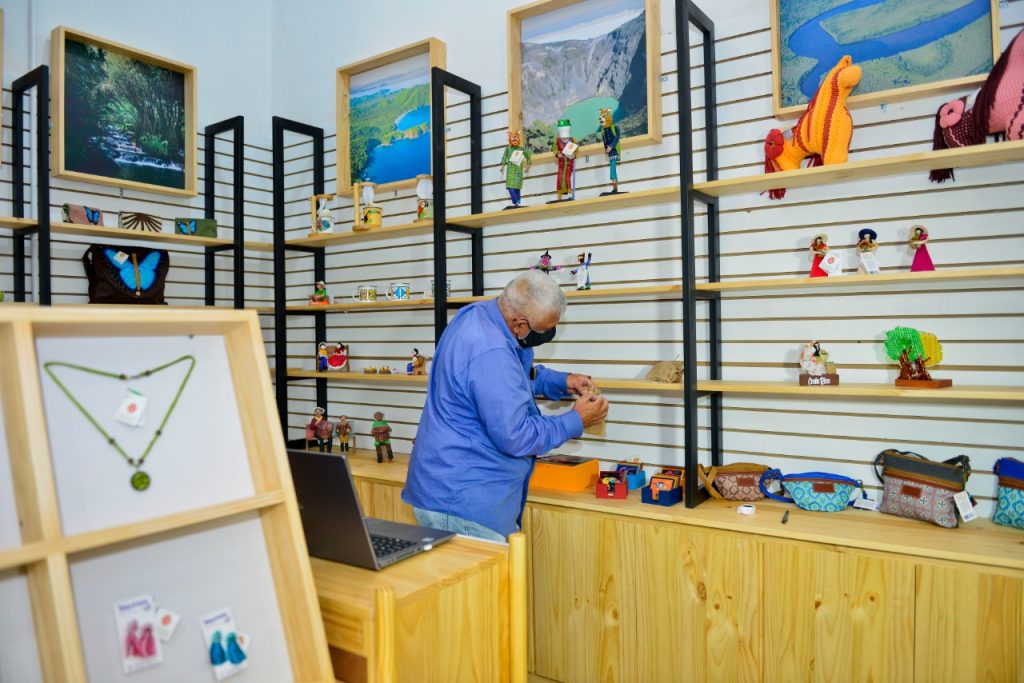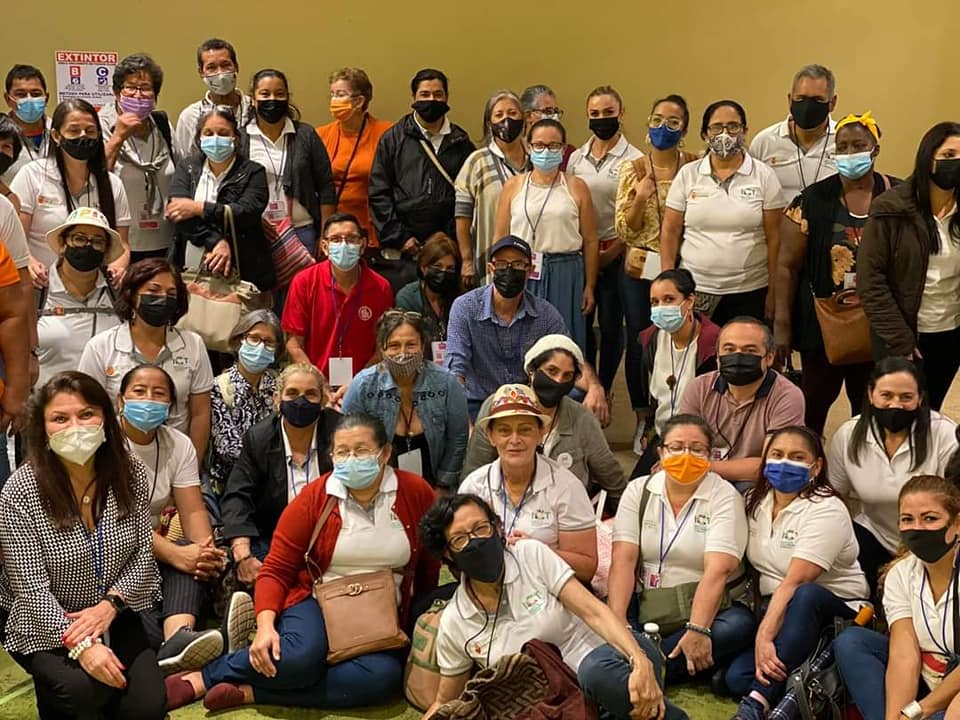There’s something magical about buying souvenirs. Perhaps it is because of the new color combinations, flavors, and shapes, or because of the treasured experiences they capture. Buying souvenirs, especially to take to others who are waiting for us at home, is something very difficult to resist.
If you’re planning to do some shopping while visiting Costa Rica, but you’ve also been thinking about how to plan a trip with a positive impact, how many destinations to include in that trip, and how to choose tours that make a difference, we want to help you so that, once again, your powerful tourist dollar can go further.
Why? Because the objects you take home are much more than just a memory.
“A handicraft or an artisanal souvenir is not just a product. There is a story behind each product that makes it special and original,” says Ruth Alfaro, Head of Tourism Development at the Costa Rican Tourism Institute (ICT). “All the hard work, the quality of the material, the finishing touches, the healthy environmental practices, the roots in local identity. The artisan techniques. The passion and the traditions of those who make it part of our cultural heritage.”

Look for authentic souvenirs made by locals.
“To make sure you’re buying authentic and truly Costa Rican souvenirs, always look at the label,” says Galit Flasterstein, CEO and co-founder of Local Keeps, an online store of Costa Rican products. “Some souvenir shops sell products mass-produced outside of Costa Rica. If it is in a souvenir shop, and the product does not have a label, it could be that the product was not made in Costa Rica and therefore is not authentic.”
This practice is not new: we all know the importance of the obligatory and famous “Made in…” label. However, as Galit mentions, there is no shortage of those who try to deceive. That is why in Costa Rica there are many initiatives that strive to highlight national products.
The Costa Rican government has created several programs that not only support these small and medium businesses but also assure visitors that they are buying authentic products. On is Artesanías con Identidad (Crafts with Identity), which according to the Costa Rican Tourism Institute (ICT) website, is a project “where artisans build their design lines by incorporating techniques they have used before, with elements of their personal and local identity as a differentiating stamp. In the end, they are creating utilitarian and decorative articles with a human face, which express innovation, history, identity, and quality using local materials.”
Another way to identify authentic products created by Costa Rican artisans is to look for the Costa Rican Artisan Seal another distinction granted by the Costa Rican government that allows the artisan to place “a sticker on the Costa Rican handicrafts so that consumers can differentiate them from similar products that come from other countries.”
There are also other organizations such as the Chietón Morén Cultural Association, which sells crafts from all Costa Rican indigenous ethnic groups without intermediaries in its museum and store in downtown San José. The association’s board of directors is made up of representatives of all ethnic groups, and its mission is to ensure not only the authenticity and quality of the product but also fair payment to the artisan. The store in downtown San José is located on the National Museum boulevard, but it has also recently ventured into selling its products online.
Of course, many Costa Rican artisans sell their products directly at local fairs, street markets, and even small shops in communities, lodgings, and restaurants.
“It’s best to ask how and where the product was made,” Galit recommends for these situations. After you hear the answer, it’s up to you to decide how satisfactory it is.
Extend your shopping experience beyond the limits of your visit.
Internet shopping has also reached the world of Costa Rican souvenirs. Many vendors offer national and international shipments of their products and crafts. That is another way to continue supporting the country, especially when your suitcase is full.
When you visit stores and markets of Costa Rican products, take with you the information you need to buy those products from home for future celebrations. You can also ask artisans if they can ship the souvenirs you’re holding to your home. Many already provide that service.
Also, consider checking out sites like Local Keeps, co-founded by Galit.
“Local Keeps was created to provide an online purchase service for products made in Costa Rica for small and medium-sized businesses,” she explains. “Most SMEs don’t know how to export, so they can’t grow outside the country. Local Keeps was created as a means for these companies to be able to export through our platform, and therefore, become known in the rest of the world and grow.”
But buying from services like Local Keeps, government initiatives such as the Hecho por mujeres/Buy from Women online store, or Chietón Morén, has another advantage.

“We carry out a process of curation through which we not only confirm that the product we are going to sell is of high quality, but also that those who produce it are sustainable and environmentally friendly SMEs whose mission is to generate an impact on Costa Rican society,” explains Galit about the Local Keeps experience.
You might also take a different approach to what constitutes a souvenir, and extend the impact of your tourist dollar even more: we also invite you to consider donations to Costa Rican organizations that are working for the environmental, cultural, and social well-being of the country. The U.S. nonprofit organization Amigos of Costa Rica connects international donors with Costa Rican organizations that have demonstrated not only their impact in the country but also their transparency in the work they do.
Why is it important to buy authentic and local?
“Buying a product made in Costa Rica benefits many people, from those who provided the raw material to those who finished the product,” says Galit. “If we take into account that 97% of the companies in Costa Rica are PYMES [small and medium enterprises], most of our society depends on the work provided by these companies. For this reason, each purchase of a souvenir actually made in Costa Rica will not only be a memory of that unforgettable travel experience to our country, but will also contribute to the economy of many people, and will help the country to continue growing.”

ICT’s Ruth lists a large number of other benefits:
- The rescue and promotion of a series of crafts and the particular culture and history of each region.
Stimulating artisans to research their traditions, culture, and history so they can offer products full of Costa Rican soul. - Promote the love for the local culture and pride in its roots and traditions.
- Encourage artisans’ children and relatives to preserve traditional production.
- Increased self-esteem of artisans and vendors who generate better living conditions for their families from the development of their enterprise.
At El Colectivo 506, we second this. Your support for Costa Rican artisans is a way of validating the work they do.
How much satisfaction will a traditional shoemaker feel if you admire and buy her handmade shoes or a tailor who has created an apron you want to wear the next time you host a dinner?
But also, remember that spending time on your shopping experience can also bring another kind of profit. How much can a children’s game designer innovate and improve when you tell him about a traditional game that you play with your children or grandkids? How much might a carpenter innovate when you explain to her which tools are most important when cooking in your country? How much more will you learn about Costa Rica by interacting with its artisans?
That positive encounter of cultures, that appreciation, and understanding of the other, can spring from the simple act of buying a souvenir. Enjoy it!

We are grateful for the support of Travel with Ann Experiential for the travel content in our January edition, “Toolkit 2022.” Ann Becker has been a small business owner throughout her career. With more than three decades of experience in meeting/event management and strategy consulting combined with a passion for travel rooted in deep, mutually beneficial human encounters, in 2005 she began Travel with Ann Costa Rica. For 15 years she created and led more than 40 small group experiential trips in Costa Rica, neighboring countries, and Chile. Today, through Travel with Ann Experiential, Ann is dedicated to supporting and strengthening responsible travel small businesses, nonprofit organizations, and industry leaders by forging strategic connections; contributing fresh perspectives; engaging and elevating diverse voices; and strengthening organizational capacity.







